
Iqaluit is the capital of the Canadian territory of Nunavut, its largest community, and its only city. It was known as Frobisher Bay from 1942 to 1987, after the large bay on the coast on which the city is situated. The northernmost city in Canada, its traditional Inuktitut name was restored in 1987.

The Inuit languages are a closely related group of indigenous American languages traditionally spoken across the North American Arctic and the adjacent subarctic regions as far south as Labrador. The Inuit languages are one of the two branches of the Eskimoan language family, the other being the Yupik languages, which are spoken in Alaska and the Russian Far East. Most Inuit people live in one of three countries: Greenland, a self-governing territory within the Kingdom of Denmark; Canada, specifically in Nunavut, the Inuvialuit Settlement Region of the Northwest Territories, the Nunavik region of Quebec, and the Nunatsiavut and NunatuKavut regions of Labrador; and the United States, specifically in northern and western Alaska.
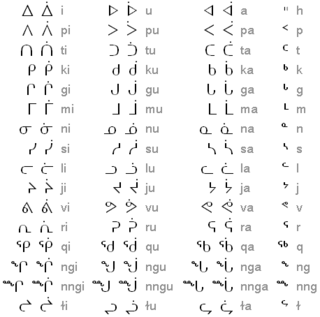
Inuktitut syllabics is an abugida-type writing system used in Canada by the Inuktitut-speaking Inuit of the territory of Nunavut and the Nunavik and Nunatsiavut regions of Quebec and Labrador, respectively. In 1976, the Language Commission of the Inuit Cultural Institute made it the co-official script for the Inuit languages, along with the Latin script.

Rankin Inlet is an Inuit hamlet on the Kudlulik Peninsula in Nunavut, Canada. It is the largest hamlet and second-largest settlement in Nunavut, after the territorial capital, Iqaluit. On the northwestern Hudson Bay, between Chesterfield Inlet and Arviat, it is the regional centre for the Kivalliq Region.
Inuvialuktun comprises several Inuit language varieties spoken in the northern Northwest Territories by Canadian Inuit who call themselves Inuvialuit. Some dialects and sub-dialects are also spoken in Nunavut.

Inuinnaqtun, is an Inuit language. It is spoken in the central Canadian Arctic. It is related very closely to Inuktitut, and some scholars, such as Richard Condon, believe that Inuinnaqtun is more appropriately classified as a dialect of Inuktitut. The government of Nunavut recognises Inuinnaqtun as an official language in addition to Inuktitut, and together sometimes referred to as Inuktut. It is spoken in the Northwest Territories as well and is recognised as an official language of the territory in addition to Inuvialuktun and Inuktitut.

Inuktitut, also known as Eastern Canadian Inuktitut, is one of the principal Inuit languages of Canada. It is spoken in all areas north of the North American tree line, including parts of the provinces of Newfoundland and Labrador, Quebec, to some extent in northeastern Manitoba as well as the Northwest Territories and Nunavut. It is one of the aboriginal languages written with Canadian Aboriginal syllabics.
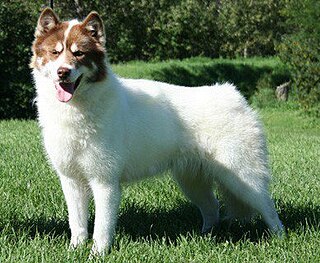
The Canadian Eskimo Dog or Canadian Inuit Dog is a breed of working dog from the Arctic. Other names include qimmiq or qimmit. The Greenland Dog is considered the same breed as the Canadian Eskimo Dog since they have not yet diverged enough genetically to be considered separate breeds, despite their geographic isolation.
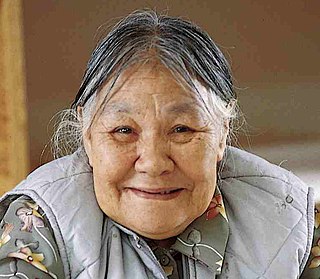
Kenojuak Ashevak,, is celebrated as a leading figure of modern Inuit art.

Kinngait, known as Cape Dorset until 27 February 2020, is an Inuit hamlet located on Dorset Island near Foxe Peninsula at the southern tip of Baffin Island in the Qikiqtaaluk Region of Nunavut, Canada.
Kenn Harper is a Canadian writer, historian and former businessman. He is the author of Give Me My Father's Body, an account of Greenland Inuk Minik Wallace, had a regular column on Arctic history in Nunatsiaq News and is a former landlord.
Lena Pedersen or Lena Pederson is a politician and social worker from Nunavut, Canada. In 1959, she moved from Greenland to the Northwest Territories and lived in Coppermine (Kugluktuk), Pangnirtung and Rae (Behchoko) before moving to Cape Dorset where she participated in the artwork sales of the West Baffin Eskimo Co-operative.

Peter Pitseolak (1902–1973) was an Inuk photographer, sculptor, artist and historian. Pitseolak was Baffin Island's first indigenous photographer.
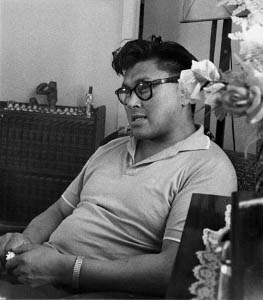
Abraham "Abe" Okpik, CM was an Inuit community leader in Canada. He was instrumental in helping Inuit obtain surnames rather than disc numbers as a form of government identification. He was also the first Inuk to sit on what is now the Legislative Assembly of the Northwest Territories and worked with Thomas Berger.

Inuit are a group of culturally and historically similar Indigenous peoples traditionally inhabiting the Arctic and subarctic regions of North America, including Greenland, Labrador, Quebec, Nunavut, the Northwest Territories, Yukon (traditionally), Alaska, and Chukotsky District of Chukotka Autonomous Okrug, Russia. Inuit languages are part of the Eskimo–Aleut languages, also known as Inuit-Yupik-Unangan, and also as Eskaleut. Inuit Sign Language is a critically endangered language isolate used in Nunavut.
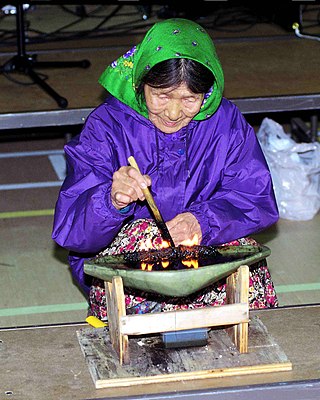
The Inuit are an indigenous people of the Arctic and subarctic regions of North America. The ancestors of the present-day Inuit are culturally related to Iñupiat, and Yupik, and the Aleut who live in the Aleutian Islands of Siberia and Alaska. The term culture of the Inuit, therefore, refers primarily to these areas; however, parallels to other Eskimo groups can also be drawn.
Project Surname was a project enacted by the Northwest Territories Council and Government of Canada to assign surnames to Inuit. Project Surname was also known as Operation Surname. These assigned surnames eventually replaced the disc number system, where numbers were assigned and kept on discs that people were obligated to wear from the 1940s onward. Family surnames were not used by Inuit until this system was introduced. Traditionally, children received multiple names after birth which reflected their personality, named for a dead relative or sometimes after a living relative. Names would be changed if they were not deemed to suit the child. Project Surname was perceived as less offensive compared to the disk number system but was also criticized as paternalistic intervention from the Canadian government.
Norma Dunning is an Inuk Canadian writer and assistant lecturer at the University of Alberta, who won the Danuta Gleed Literary Award in 2018 for her short story collection Annie Muktuk and Other Stories. In the same year, she won the Writers' Guild of Alberta's Howard O'Hagan Award for the short story "Elipsee", and was a shortlisted finalist for the City of Edmonton Book Award. She published in 2020 a collection of poetry and stories entitled Eskimo Pie: A Poetics of Inuit Identity.

Simonie Michael was a Canadian politician from the eastern Northwest Territories who was the first Inuk elected to a legislature in Canada. Before becoming involved in politics, Michael worked as a carpenter and business owner, and was one of very few translators between Inuktitut and English. He became a prominent member of the Inuit co-operative housing movement and a community activist in Iqaluit, and was appointed to a series of governing bodies, including the precursor to the Iqaluit City Council.













